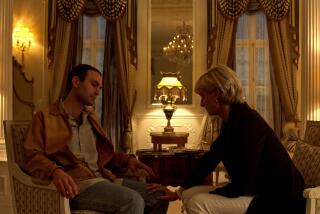Diana’s Floral Tributes Are Gently Moved
LONDON — It was easy to deal with flowers when Diana, princess of Wales, was alive. When people filled her arms with blooms at a public appearance, she handed them off to a lady-in-waiting, who handed them off to someone else, who donated them to a hospital.
But in the wake of her death, it took a small army of people at St. James’s Palace on Thursday to begin the handoff of an estimated 10,000 to 15,000 tons of flowers that carpet the city in her honor.
About 40 volunteers and 15 groundskeepers--some wielding cellular phones so they could talk from one garden to another--started sorting the millions of dust-caked flowers, cards, toys and votive candles left by mourners from across the country.
In a genteel but efficient manner, the cleanup crew left no flower or message uncollected, mirroring the enormous reverence that the British public has for these piles of offerings to the late Diana.
“I just thought it would be an honor to do this,” said Rachel Goldsmith, a 13-year-old volunteer from Sussex.
Outside the palace, where Diana’s coffin had rested before her funeral, uniformed Scouts and Guides, some wearing latex gloves, scooped up bouquets from grass and dirt paths and took them to a line of 10 rectangular tables bordering a wide promenade.
Fresh flowers were placed in 3-foot-high black plastic pails filled with water; dying blooms were stuffed into other buckets.
Volunteers from the Women’s Royal Voluntary Service--in the orange tunics that easily identify them at the disaster sites and public events they usually work--separated the flowers, cutting off wrappings and undoing rubber bands.
Cards were detached from wrappers and coaxed off fence posts. Thumbtacks were pried off tree trunks to free notes stuck to bark. Messages written on bouquet wrappings were cut off and saved.
The volunteers worked diligently, oblivious to the resplendent mounted regiment parading past after the changing of the guard at Buckingham Palace.
The workers--who were respectful but not morose--paused occasionally to linger over notes that caught their attention or to hold up toys they found amusing.
One chuckled at the dust covering her hands and clothes, saying, “You can’t scratch your nose because you get big black marks on your face.”
Since the day after Diana’s death, the groundskeeping staff has been working 16- and 18-hour days. Some have canceled vacations. One staffer came back to work the day after his wife delivered a baby.
On Thursday, groundskeepers darted about, keeping tabs on progress and swiftly moving flowers off-site. Four trucks stood ready--as did a horse and wagon with its crisply suited master.
The live flowers went into a van bound for a nursery in Hyde Park, and from there to various hospitals, possibly via taxis that have volunteered their services.
But 90% of the flowers were dead or dying; those were taken in flatbed trucks to the Kensington Gardens leaf yard, where gardeners will compost them for mulch to be used in Kensington Gardens and other royal parks.
Messages, cards, drawings and the numerous paintings of Diana left among the flowers went in sturdy white boxes to a storage facility in nearby Regent’s Park, where dehumidifiers will dry any wet papers.
Two archivists from the British Library will advise officials on how best to preserve the mementos, according to David Welch, chief executive of the Royal Parks division of the government’s Department for Culture, Media and Sport.
“They’re an important testament to people’s feelings and probably an important social document,” said Welch as he watched the cleanup.
Toys will be given to the Women’s Royal Voluntary Service for distribution to “toy libraries” and other charities.
The Thursday cleanup was a dress rehearsal for the daunting task of clearing flowers from the grounds at Kensington Palace, Diana’s home about two miles away.
The items at St. James’s are a “drop in the ocean,” as one government official put it, compared to the football field’s worth of tributes outside Kensington’s gates.
Sweep-up efforts begin today at Kensington--where the piles of flowers rise to nearly 5 feet with more blooms arriving daily--and at Buckingham Palace.
Officials expect the cleanup of the three palace grounds and gardens to take five weeks.
The public here has been deeply respectful of the tributes, perusing the flowers and reading the notes as if the offerings are as much for them as for the princess’ family.
A few who dared pilfer have been treated like defilers of holy temples. A 20-year-old Sardinian tourist who stole a teddy bear was given a 100-pound (about $160) fine by a magistrate and a punch in the face by an irate Londoner outside the court Wednesday.
More to Read
Sign up for Essential California
The most important California stories and recommendations in your inbox every morning.
You may occasionally receive promotional content from the Los Angeles Times.











